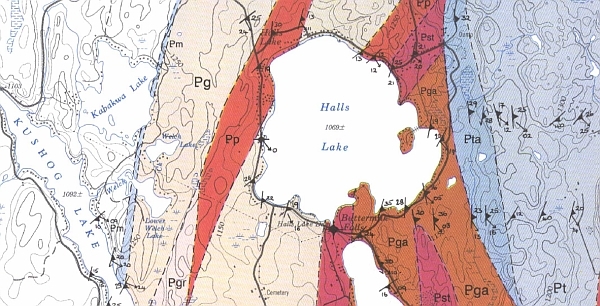Heavy mineral sand is probably my favorite sand type. They are natural concentrates of many interesting minerals. These sands are beautiful to look at and very educational as well. Here is a sample taken from the shore of Halls Lake, Ontario, Canada. Thanks to Frances Vandervoort for this sample.
My photo equipment unfortunately is at its limit here. This sand and many other good samples are too fine-grained. I hope I will soon be able to take higher magnification images.
Most important components of this sand are quartz (which is hardly surprising) and actinolite (it isn’t rare either but usually not as abundant as here). Quartz is transparent and actinolite is black. Actinolite is a member of amphibole group. Other notable minerals are almandine, orthoclase, epidote, augite, pumpellyite, and magnetite.
Some of you might ask that how can you possibly be so sure about these minerals? How can you say that this feldspar is orthoclase and amphibole is actinolite? Indeed, this is difficult, and I do not claim to have an ability to do this with optical microscope only. X-ray diffraction is the keyword here. This technique significantly helped me in the identification process.
What is the possible source rock of this sand? To say that for sure, one really needs to go out and familiarize him/herself with the local geology. I have never been there, so I can only theorize. Most minerals seem to point to the metamorphic source. This part of Canada is a shield. There is lots of very old (Proterozoic) metamorphic and igneous stuff there.
Actinolite could form in metamorphosed calcareous sediments but it could be a product of regional metamorphism also (glaucophane schist facies). Pumpellyite also favors regional metamorphism and glaucophane schist facies but unfortunately there is no trace of glaucophane itself. Augite points to igneous source. Almandine usually comes from schist (regional metamorphism). This sand most likely has several if not many source rocks contributing to its composition but some of them can not be far away. Actinolite for example looks fresh and is very abundant here but its resistance to weathering processes is not good.

Sand sample from Ontario, Canada. The width of the view is 10 mm.
Update
Thanks to Howard I just discovered from where to download Canadian geological maps. Here is an excerpt from a geological map of Halls Lake area:

Geological map of Halls Lake area. The sample was probably collected at the NW corner of the lake. Photo courtesy: Department of Natural Resources Canada.
Pg — Irregular granitic gneiss
Pga — Regular granitic gneiss
Pp — Porphyroclastic gneiss
Pst — Granitic straight gneiss
Pta — Medium to fine-grained tonalitic straight gneiss
Pt — Coarse biotite-hornblende orthopyroxene tonalitic orthogneiss 1450-1300 Ma.
Actinolite probably comes from gneiss (Pp). Hopefully it is amphibolitic gneiss. It could be Pt also. Maybe this ‘hornblende’ there is a field term? Sometimes geologists have a habit to name it hornblende whenever they see black amphibole.
Hi, Siim–
Must be nice to have access to XRD equipment! You can download a geological map of the Halls Lake (no apostrophe) area, here: http://apps1.gdr.nrcan.gc.ca/mirage/db_search_e.php (enter “1688a” in the Number search field). Looks like several types of metasedimentary gneiss form the bedrock around the lake, as you supposed. Of course in this area there’s the added complication of continental glaciation that covered the area not that long ago, so there could be contamination from rocks nowhere near Halls Lake.
Cheers
Thanks, Howard. I hoped that you would step in. Thse maps could become very valuable to me. I like US samples because there are Google Earth kmz files downloadable for every state. Do you know is there such files for Canada also?
Siim–
I don’t know of any geological kmz files for Canada, sorry. I didn’t know they were available for the US–what sort of data do they contain?
These files are here: http://tin.er.usgs.gov/geology/state/ They contain lithological data. It is good that they work with Google Earth. I can directly navigate to the place I want if I know the geographical coordinates. Then click on the map and get the data. No need to look for a legend.
In most cases every geological survey has its own software solutions (if they exist at all). It is especially true in Europe. Additional misery plagueing this continent is that everyone speaks their own language. Canada will definitely do it before Europe as a whole can even start thinking about something remotely similar.
Hi, Siim–
Thanks for the link. I’ve searched for KML data on the Geological Survey of Canada (GSC) site, and they don’t seem to have anything similar to the USGS tools. GSC does have some KML overlays, but only for specific studies of small areas (e.g. landslides) and no bedrock geology overlays. I thought it was a miracle that the GSC even has scans of all their geological maps available for free. I’m not holding my breath waiting for the GSC to create GE overlays: Canada is a huge country with a relatively small tax base (only 35 million people), and geological mapping is low on the list of government priorities.
In the past, I’ve created my own Google Earth bedrock geology overlays, by simply importing JPEG or PNG images of the maps. These aren’t as convenient as the USGS overlays, because you have to fiddle with getting the maps scaled and aligned properly. However, once you get them fitted, they work nicely, because you can adjust the transparency, so you can see the map overlay and the underlying topography (including roads, rivers, etc.) at the same time.
I live in a rural area of Ontario, Kawartha Lakes region. We have so much sand here it’s amazing. When I walk up our country road – which is almost impassable to cars, the whole road is sandy. Where does this sand come from? We are quite high, at least 978 ft above sea level.
Thanks,
Ann